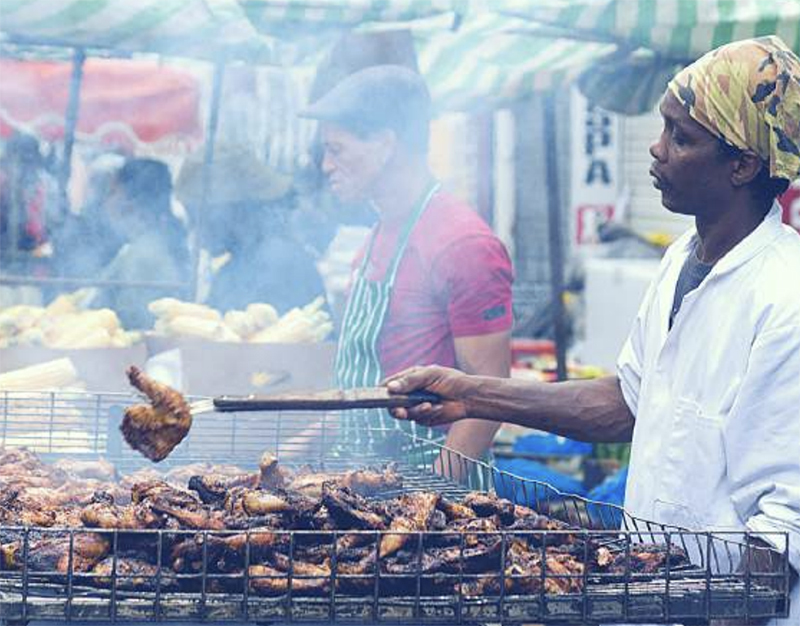
If you’re looking for the perfect getaway destination this summer, it might be closer than you think. On July 14 and 15 in Clifton Park, the Baltimore Washington One Carnival, otherwise known as the Baltimore Caribbean Carnival, will bring all the island essentials right to the streets of Charm City: color, costumes, and, perhaps most importantly, cuisine.
With over 25 food vendors to choose from—and thousands of attendees to beat to the front of the lines—finding the best dishes can be difficult. Luckily, we’ve got the inside scoop on the most authentic, can’t-miss fare you can find at this year’s festival.
Jerk chicken
Jerk chicken is one of the most iconic Caribbean dishes you’ll find on the islands or in the States. Originally a Jamaican style of cooking, “jerk” refers to the method of seasoning meat—in this case, chicken—with a dry-rub or a marinade made of allspice, often called pimento in Caribbean culture, and scotch bonnet peppers. (If you’re spice-averse, look out: scotch bonnet peppers, also called Caribbean red peppers, average about 500,000 Scoville heat units. In comparison, jalapeños usually rank at about 8,000.) Jerk chicken is often cooked in wood-burning ovens to give it that rich, smoky flavor that makes this dish an annual go-to at the Caribbean Carnival.
Curried goat
Another Indo-Caribbean favorite is curried goat. Although some people are hesitant to deviate from chicken and beef, goat is one of the popular meats in the world. Due to common religious customs in Southeast Asia and the Caribbean that prohibit the consumption of beef and pork, goat is a typical, delicious alternative. In fact, the protein is such a star on Caribbean dinner tables that a goat-based stew called goat water is the national dish of the island of Montserrat. At the carnival, check out curried goat—a thick, slow-cooked stew that is brightened with flavors from ginger, hot peppers, thyme, garlic, onions, and, of course, curry. What’s more, goat is a low-fat, high-protein meat that won’t weigh you down as you partake in the lively festivities all weekend long.
Fry fish
If there’s one culinary crossover between the Caribbean islands and Baltimore, it’s that seafood is king. Fry fish, or fried fish, is a Caribbean classic. Loughton Sargeant, the executive director of the D.C. Caribbean Carnival Committee, said that fry fish can be found in two forms at the carnival this year: Escovitch style, which involves dry-frying the fish and topping it with a mix of crisp vegetables, and what he calls “stew-style,” in which the fish is fried and then doused in a rich brown stew sauce that’s as hearty as it is traditional.
Oxtail
Originally, oxtail was exactly what it sounds like: the tail of an ox. As the dish has become more popular beyond the Caribbean, however, oxtail can now refer to the tail of any sort of cattle, but the minutia has had no consequence on its unctuous flavor. To the surprise of many oxtail newbies, cattle tails are very meaty and can weigh up to four pounds. In Caribbean cuisine, oxtail is traditionally prepared in a fatty soup or stew, or slow-cooked and served over rice. While you’re at the carnival, the over-rice style might be a bit easier to eat on-the-go, but both are equally delectable.
Pelau
Pelau is to Trinidad and Tobago what crab is to Baltimore: quintessential, widespread, and served with just about everything. Pelau is a rice dish commonly simmered with peas, carrots, hot peppers, meats, and an aromatic blend of seasonings, such as parsley, thyme, ketchup, sugar, and sometimes a touch of barbecue sauce. Pelau is a perfect plate for the Caribbean Carnival: mobile-friendly, packed with flavor, and often served in sharing-size portions.
Roti
Although not usually a full meal on its own, roti is a thin, unleavened flatbread that is everywhere throughout South Asia and the Caribbean islands, particularly Trinidad and Tobago, Jamaica, St. Lucia, Guyana, and Suriname. Perhaps roti’s most defining characteristic is its base made from a wheat flour called atta, which is often stone-ground and contains all the nutritious parts of the wheat grain that white flour often filters out. Roti is a perfect pairing with any meat, stew, or veggie dish. Elaine Simon, the president of the Caribbean American Carnival Association of Baltimore, said that several food vendors at this year’s carnival will sell roti as a side for larger entrées.
Pholourie
Pholourie, also spelled phulourie or phoulourie, is the perfect midday festival snack. Hugely popular in Trinidad and Tobago and also a widespread street food in Guyanese and Surinamese cuisines, pholourie consists of spiced, fried chickpea dough balls. Slightly crispy on the outside, warm and satisfying on the inside, these little dough balls are full of flavor. The dough is commonly seasoned with garlic, cumin, pepper, curry, and cilantro before they hop in the deep frier. At the Caribbean Carnival, you can try pholourie with sides such as mango or tamarind chutneys to balance the deep fried snack, or velvety yogurt sauces to taste one of the simplest Caribbean decadences.
